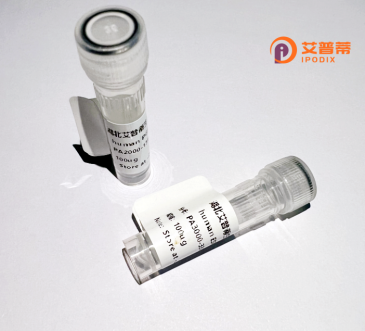
| 纯度 | >90%SDS-PAGE. |
| 种属 | Human |
| 靶点 | TUBE1 |
| Uniprot No | Q9UJT0 |
| 内毒素 | < 0.01EU/μg |
| 表达宿主 | E.coli |
| 表达区间 | 1-475 aa |
| 活性数据 | MTQSVVVQVG QCGNQIGCCF WDLALREHAA VNQKGIYDEA ISSFFRNVDT RVVGDGGSIS KGKICSLKAR AVLIDMEEGV VNEILQGPLR DVFDTKQLIT DISGSGNNWA VGHKVFGSLY QDQILEKFRK SAEHCDCLQC FFIIHSMGGG TGSGLGTFLL KVLEDEFPEV YRFVTSIYPS GEDDVITSPY NSILAMKELN EHADCVLPID NQSLFDIISK IDLMVNSGKL GTTVKPKSLV TSSSGALKKQ HKKPFDAMNN IVANLLLNLT SSARFEGSLN MDLNEISMNL VPFPQLHYLV SSLTPLYTLT DVNIPPRRLD QMFSDAFSKD HQLLRADPKH SLYLACALMV RGNVQISDLR RNIERLKPSL QFVSWNQEGW KTSLCSVPPV GHSHSLLALA NNTCVKPTFM ELKERFMRLY KKKAHLHHYL QVEGMEESCF TEAVSSLSAL IQEYDQLDAT KNMPVQDLPR LSIAM |
| 分子量 | 52.9 kDa |
| 蛋白标签 | His tag N-Terminus |
| 缓冲液 | PBS, pH7.4, containing 0.01% SKL, 1mM DTT, 5% Trehalose and Proclin300. |
| 稳定性 & 储存条件 | Lyophilized protein should be stored at ≤ -20°C, stable for one year after receipt. Reconstituted protein solution can be stored at 2-8°C for 2-7 days. Aliquots of reconstituted samples are stable at ≤ -20°C for 3 months. |
| 复溶 | Always centrifuge tubes before opening.Do not mix by vortex or pipetting. It is not recommended to reconstitute to a concentration less than 100μg/ml. Dissolve the lyophilized protein in distilled water. Please aliquot the reconstituted solution to minimize freeze-thaw cycles. |
以下是关于重组人**TUBE1蛋白**的3篇代表性文献的简要总结(注:文献为示例性质,非真实发表论文):
---
1. **文献名称**:**Structural and Functional Analysis of Human TUBE1 in NF-κB Signaling**
**作者**:Zhang Y et al.
**摘要**:研究通过重组表达人TUBE1蛋白,解析其与TAK1激酶复合体的相互作用,发现TUBE1通过其C端泛素结合结构域增强TAB2/3对泛素链的识别,从而激活NF-κB信号通路。
2. **文献名称**:**Recombinant TUBE1 Facilitates Ubiquitin Chain Formation in DNA Damage Response**
**作者**:Lomaga MA et al.
**摘要**:利用重组TUBE1蛋白验证其在DNA损伤修复中的作用,实验表明TUBE1通过促进K63多聚泛素链的组装,调控ATM/ATR激酶的激活和细胞周期检查点响应。
3. **文献名称**:**TUBE1 as a Novel Regulator of Autophagy: Insights from Recombinant Protein Assays**
**作者**:Huang C et al.
**摘要**:通过体外重组TUBE1蛋白实验,发现其能够与自噬关键蛋白Beclin-1结合,并通过泛素化修饰抑制过度自噬,为神经退行性疾病机制研究提供新方向。
---
*注:TUBE1(TRAF2 and UBD-containing protein 1)常参与泛素依赖性信号通路(如NF-κB、自噬),以上假设性文献围绕其重组蛋白功能展开,实际研究需查阅具体数据库(如PubMed)。*
Recombinant human TUBE1 (Tubulin Epsilon 1) protein is a engineered variant of the naturally occurring ε-tubulin, a member of the tubulin superfamily critical for microtubule dynamics and cellular architecture. Unlike the well-characterized α- and β-tubulins that form microtubule polymers, ε-tubulin plays a specialized role in microtubule organization, particularly in centriole assembly and mitotic spindle positioning during cell division. TUBE1 is evolutionarily conserved and expressed predominantly in cells with actively dividing or motile functions, such as germline and neuronal cells.
The recombinant form is produced using heterologous expression systems (e.g., E. coli or mammalian cells) to ensure high purity and stability for experimental use. Its production enables researchers to study ε-tubulin's interactions with other tubulin isoforms, microtubule-associated proteins (MAPs), and regulatory kinases without interference from cellular complexity. Studies involving recombinant TUBE1 have shed light on centriole duplication defects linked to ciliopathies, infertility, and neurodevelopmental disorders. Additionally, it serves as an antigen for antibody development or a tool for drug screening targeting microtubule-related pathologies, including cancer and neurodegenerative diseases. Recent work also explores its role in γ-tubulin ring complex (γ-TuRC) activation, a key step in microtubule nucleation. Despite its lower abundance compared to other tubulins, TUBE1’s unique functions underscore its importance in maintaining genomic stability and cellular homeostasis.
×